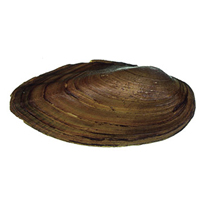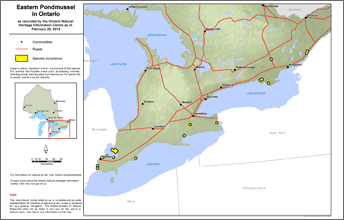Eastern pondmussel
Scientific name: Ligumia nasuta

Cover photo credit: Field Guide to the Freshwater Mussels of Ontario
Status
Special Concern
“Special Concern” means the species lives in the wild in Ontario, is not endangered or threatened, but may become threatened or endangered due to a combination of biological characteristics and identified threats.
Date added to the Species at Risk in Ontario List
February 18, 2009. The species was reassessed as special concern in November 2017.
Read the assessment report (PDF).
What it looks like
The Eastern Pondmussel is a medium-sized freshwater mussel that can grow to 10 cm long.
The shells of adults are dark brown or black, while juveniles are yellow-green.
The shell is rough with growth lines that resemble the growth rings on a tree stump.
Where it lives
The Eastern Pondmussel is typically found in sheltered areas of lakes and in slow-moving areas of rivers and canals with sand or mud bottoms.
All mussels filter water to find food, such as bacteria and algae.
Mussel larvae must attach to a fish (called a “host”), where they consume nutrients from the fish body until they transform into juvenile mussels and drop off the fish host.
It is not known which species of fish act as hosts for the Eastern Pondmussel.
Where it’s been found in Ontario
In North America, the Eastern Pondmussel was once one of the most common mussels in the lower Great Lakes.
In Canada, there are now only two known populations: one in the delta area of Lake St. Clair and the second in Lyn Creek, a small tributary of the upper St. Lawrence River.
View a Larger version of this map (PDF)
What threatens it
The greatest threat to the Eastern Pondmussel is the Zebra Mussel.
This invasive species attaches to other mussels in large numbers, causing them to suffocate or die from starvation.
The Zebra Mussel is largely responsible for the disappearance of this species from 90% of its historical range.
Changes in water levels resulting from climate change may also threaten the species’ habitat.
Any conditions that threaten the fish host also threaten the Eastern Pondmussel.
Action we are taking
Special concern species do not receive species or habitat protection, but may be eligible for grants to help with their protection and recovery.
What you can do
Report a sighting
- The Ministry of Natural Resources and Forestry tracks species at risk such as the Eastern pondmussel. Report a sighting of an endangered animal or plant to the Natural Heritage Information Centre. Photographs with specific locations or mapping coordinates are always helpful.
Volunteer
- Volunteer with your local nature club or provincial park to participate in surveys or stewardship work focused on species at risk.
Be a good steward
- Private land owners have a very important role to play in species recovery. If you find Eastern Sand Darter in a watercourse on or adjacent to your property, you may be eligible for stewardship programs that support the protection and recovery of species at risk and their habitats.
- If you're a land owner, you can help improve mussel habitat and keep Ontario’s water safe and clean by maintaining natural vegetation next to creeks and rivers. The roots of plants reduce erosion and can stop soil from washing into the river. Fence off streamside areas to keep cattle (and their manure) out of the water. There are many other things that you can do to help reduce soil erosion and you might be eligible for funding assistance. For more information, visit the Ontario Soil and Crop Improvement Association:
www.ontariosoilcrop.org - Invasive species seriously threaten many of Ontario’s species at risk. To learn what you can do to help reduce the threat of invasive species, visit:
www.ontario.ca/invasivespecies
www.invadingspecies.com
www.ontarioinvasiveplants.ca
www.dfo-mpo.gc.ca/science/enviro/ais-eae/index-eng.htm
Report illegal activity
- Report any illegal activity related to plants and wildlife to 1-877-TIPS-MNR (847-7667).
Quick facts
- To attract fish for its larvae to attach to, the female pondmussel produces a lure that looks like the wriggling legs of a swimming shrimp. When a fish bites the lure, the mussel ejects its larvae, which have a better chance of attaching at such a close distance.
- Eastern Pondmussel eggs hatch inside a special pouch in the mother’s gills (called a “marsupium”). The larvae remain in the marsupium throughout the winter and are ejected into the water during the spring.
- Mussels rely on a lot of good luck in order to reproduce. Males release sperm into the water and, if there happens to be a female nearby, she will capture the sperm as she filters water for food.
- Mussels are indicators of environmental health. Since they can live up to 100 years and eat by filtering water and its pollutants, mussels can provide a snapshot of how healthy our waterways are.
- Aboriginal people harvested mussels for food and to create jewelry and tools. - In the 1800s, massive numbers of mussels were harvested from the Grand River to create buttons. Millions were shipped out every year until the 1940s, when plastic became more popular.
